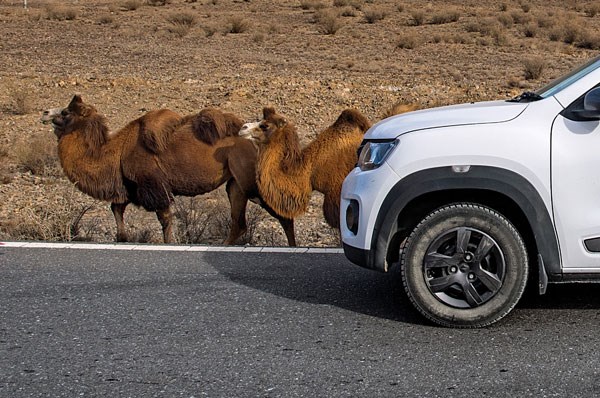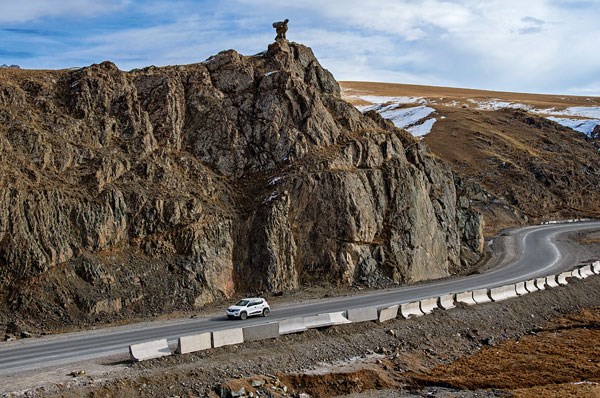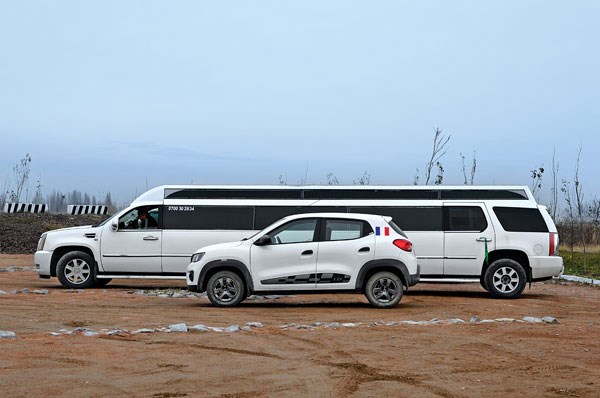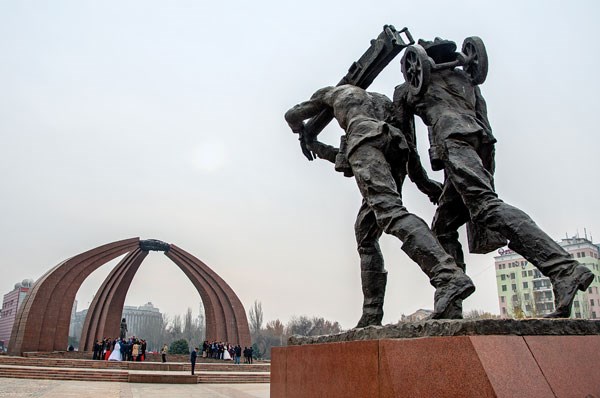Slush, snow and sleet welcome us to Central Asia as we journey on in the India-made Kwid towards Renault HQ at Paris.
Published On Apr 29, 2017 06:00:00 AM
66,631 Views
Follow us on
Bactrian (double-humped) camels are native to Central Asia. And as we learned, they’re rather photogenic too.

No, this isn’t Ladakh but the Torugart Pass that connects China to Kyrgyzstan.

Our Kwid stands its ground with one of Bishkek’s many XXL wedding mobiles.

The Victory Monument in Bishkek is dedicated to those who lost their lives in World War II.
We said it before and we’ll say it again – China is massive. It’s taken us a good two weeks to drive the 6,200km mix of fabulous expressway and stretches of no roads from the Myanmar-China border to the China-Kyrgyzstan border in the west. Note that, as of now, this was the quickest route out!
Kyrgyzstan is country number 4 of 13 for us on this mammoth drive, but the entry is a bit unusual. There’s over 100km of ‘no man’s land’ between China and Kyrgyzstan and this includes the fearsome Torugart Pass. Luckily all that threatens us today is some chilly wind, and in time we’re at the actual Kyrgyz border. Unlike the Indian shed, the Myanmari cottage and the extravagant Chinese office building, the border crossing feels a lot more militaristic here, but still very friendly. We’re stamped and through with Immigration and Customs and are now well and truly in Central Asia.

We spend the night in the town of Naryn, treated to an altogether different style of hospitality. The food too has changed drastically – roast chicken, grilled trout and kebabs are now the staple. This definitely isn’t China anymore.
Central Asia sojourn
Kyrgyzstan’s capital Bishkek is where we headed to next and it was scheduled as a stop for rest and recuperation. Of course, rest we did not; we had a new city to explore. Prominent sights on our list of must-sees included the city’s central area, Ala-Too Square, the impressive old Parliament house and the Victory Monument which was built in memory of those who lost their lives in World War II. As it turned out, we were out on the town on a very auspicious day. Decked-up brides and beaming grooms were to be seen all across the city and never too far from an enormously stretched SUV – seemingly the rental vehicle of choice for Bishkek’s newly-weds. The city isn’t too big, so the sightseeing didn’t take all that long. We did put the remainder of our time here to good use by giving the Kwid some much needed TLC. The car received its routine 10,000km service that got it a new air filter, an oil change and a throttle body clean-up. While the car was prepped and good to go, some of us weren’t quite as eager to leave… the superb shashliks are still playing on our minds.
The next morning was to be an early start but things didn’t quite go as planned. Nature was to blame. It had snowed through the night and it was snowing at the time of departure too. After much contemplation, we had no option but to get into the heaviest of our winter wear, brave the cold and get down to the job of scraping off the thick layer of snow on the Kwid. Thankfully, the plucky Renault showed its mettle and started at the very first crank. Just as well because the day’s journey was to have us cross into neighbouring Kazakhstan and time was of the essence. The trip until the border wasn’t easy, thanks to the snow and slush on the roads, but the Kwid on Ceat snow tyres managed just fine. A rear windscreen wiper and defogger would have been immensely helpful in this setting but the single wiper up front held its own in these testing conditions. Also, thumbs-up to the Kwid’s heater; it may have been built for an ‘Indian winter’ but it kept us cosy enough to focus on the job at hand.

Immigration and customs offices are places of serious business, but there was some comic relief for us in the relatively tense environment at Kazakhstan border control. The Kazakh immigration officer scrutinising our documents broke into a huge grin when he got hold of our videographer Mrityunjay Chakraborty’s passport. The reason for the excitement? The immigration official thought it was yesteryear’s movie star Mithun Chakraborty in front of him! It was a big deal because Mithun and his song ‘Jimmy Jimmy’, are extremely popular in this part of the world. I kid you not! And it didn’t end there. Just post the border, the owner of a small coffee shop we stopped at first gingerly confirmed if we were from India and then pointed excitedly at her TV. A popular Indian soap opera with Russian subtitles was playing. Incredible! Our movies and television shows really are our greatest exports.
Kazakhstan is the richest of the ‘stans’ that formed from the disintegration of USSR, and the wide and superbly surfaced expressway that welcomed us into the country certainly indicated so too. The road was deserted but also extensively patrolled by radar gun-armed police, so one eye was always on the speedometer. We reached Shymkent – our halt for the night – well into the evening but the feeling was of being in a vibrant city; the neon signs of the multiple eateries around town certainly made it seem so.
Deep freeze
The cold. The cold got us good and proper in Kazakhstan. Mind you, this wasn’t even peak winter in the region! We started day 28 of the journey shivering, huffing and puffing with little knowledge that it was only going to get colder in the coming days. Soon into the drive it became clear we had left urban Kazakhstan far behind. The expressways of the days before had given way to an arrow-straight dual carriageway that cut through the vast Kazakh steppes (low grasslands) like a laser. It was scenic but it wasn’t easy-going. With no trees or barriers to break its flow, the crosswind was very strong. Gusts of wind literally had the car move lanes at times, so it was crucial to keep a firm hand on the bantamweight Kwid’s steering wheel at all times. The windchill factor also came into play at photography stops. Getting out to shoot wasn’t the wisest of things to do, but then we couldn’t just pass by a flock of native Bactrian (double-humped) camels without a few clicks, could we?

We reached the town of Aralsk just in time for dinner of soup, bread and of course, more shashlik. The soup worked its magic that night but nothing could prepare us for the cold the next morning. We woke up to news that it was -23deg outside. Minus 23! That was officially the coldest for everyone in our crew. I think we now know what the inside of a freezer feels like. To add to the challenge, we were advised to rush to the fuel station to top-up the cars at the earliest. Fuel supply was erratic in Aralsk and we’d be massively delayed should the petrol station have run out. Unfortunately for us, the hurried trip to the fuel station entailed what seemed like a never-ending (okay, two hour!) wait in the dark and harsh cold for the pump to open its doors. We finally got moving when the mercury climbed to a ‘relatively bearable’ -19deg.
Apart from their effects on man, the severe cold and strong winds were also taking a toll on machine. That day we recorded the lowest fuel economy of 10.4kpl. Not what you want on a day of 600km-plus driving. And remember, the Kwid has just a 28-litre fuel tank. If that wasn’t enough, the highway to Aktobe was also devoid of fuel stations. At the one-third mark, we had no option but to tank up from jerry cans at a local garage selling fuel at an inflated price. Inflated by Kazakhstan standards that is. It still worked out to just Rs 38 per litre! As we continued on the lonesome highway, we realised if there’s one thing about being far away from civilization, it’s that you get front row seats to the most beautiful vistas. The gorgeous sunset seen through the windscreen of the Kwid almost made up for the hardships of the day.
Day 30 of the drive was our last in Kazakhstan. There are multiple borders to neighbouring Russia, but the route we took seemed to lead us through the set of a Hollywood Western. There were dry fields as far as the eye could see and even rolling tumbleweed for effect. Good, bad or ugly, the scenery didn’t change for the 300-odd kilometres right until the Russian border. Nor did our humble steed miss a beat.

Formalities at the border took long and the cold didn’t help but, heck, we were now in Russia!
From Russia with love
The advantage of travelling westward by road is that you earn a precious few hours of ‘extra time’ whenever you cross over into a new time zone. Russia has 11 time zones and the region we were in was two hours behind Kazakhstan! Unfortunately, our body clocks weren’t ready to adapt so soon; we were all up long before the alarms rang, impatiently pacing about our hotel in the tiny town of Bolshaya Chernigovka.
A long wait and a rather tasty breakfast later, we were on the road again. Immediately Russia felt very different to Kazakhstan of the day before. And it wasn’t just down to the reappearanceof trees or the changing landscape. For one, English had disappeared from the signboards. The Cyrillic script Russian is written in is hard to decipher for non-natives, so there was no way to cross-check if our GPS was taking us the right way. However, our trust in technology did come through. What was also clear was that there was a lot more activity on Russia’s roads, especially from truck traffic. Just a word of caution for anyone planning a drive through this region: always give way to trucks. Truckers here don’t honk or flash their truck’s headlights to signal an intent to overtake. Rather, tailgating seems to be the go-to approach. You can imagine how vulnerable we felt seeing the oversized grille of a 15-tonne trailer filling the rear-view mirror of our 700kg Kwid! These intimidation tactics aside, traffic on the dual carriageway was disciplined all through our journey to Syzran. The Russian authorities’ solution of placing cardboard cut-outs of police cars at strategic positions along the highway seemed to be doing more than just giving us a few laughs.

Day 32 and it was on towards Spaask. The sun was out in all its glory but there was no getting around the cold. Bottles of water left in the car had frozen overnight and just about every water body en route was now under a blanket of ice. On frigid days as this, it was immensely helpful that the Kwid’s touchscreen was responsive to inputs even through our gloves. It really was the little things that made all the difference. Of course, solyanka (Russian soup) and goulash (stew) also helped keep us running at operating temperature.
There was an air of excitement the next day because we were to drive into Russia’s capital, Moscow. We did make an earlier-than-usual start to maximise our time in the city but things didn’t go our way. Moscow is notorious for its traffic jams and we got an idea of how bad the situation is a good 25km outside the city centre. Outbound traffic was packed like sardines and the going was slow for those headed into town as well. We reached our hotel in the heart of the city well into the evening. For better or worse, our sightseeing that night was restricted to the innumerous luxury cars on Moscow’s roads. And to think this was once the capital of the Communist world!

It would have been criminal to drive through Moscow without capturing on camera at least some of the sights the city is so famous for. And that’s why we kept an entire day for photography and exploring. Our first port of call was the famous Red Square. It’s a place with so much history (apparently over 800 years worth) and man-made beauty, we found ourselves tearing in many directions all at once. On one side of the cobblestone-surfaced square is the fantastic and eccentric St Basil’s Cathedral – you know, the technicolour, onion-domed church you’d probably picture when you think of Moscow. Then there is the beautiful GUM building. It may look like a palace but was actually used as just a department store during the Soviet era! History buffs have the State History Museum and you could even visit Lenin’s Mausoleum to pay your respects to the man who changed Russia forever. It’s a pity we didn’t have the time to venture past the red walls of Moscow’s Kremlin (walled complex) just behind. It’s where a lot of Russia’s biggest political moments have played out.
When it was time to move on, the Kwid’s small size and light controls came handy in the heart of Moscow where traffic is dense and where you have a higher chance of winning the lottery than finding parking. We made our way around town passing by the iconic Gorky Park and the resplendent Cathedral of Christ the Saviour. The shining white cathedral is replete with golden domes that are an architectural identity of this part of Russia. Honestly, many of the buildings
in central Moscow just blew us away.
Copyright (c) Autocar India. All rights reserved.

Maruti Suzuki plans to use the Boosterjet engine in more models. Which one would you like to see it in?
Swift
33.10%
Baleno
15.21%
Brezza
25.98%
Jimny
25.71%
Get all the latest updates from the automobile universe

Comments
Member Login
Personal Details
No comments yet. Be the first to comment.